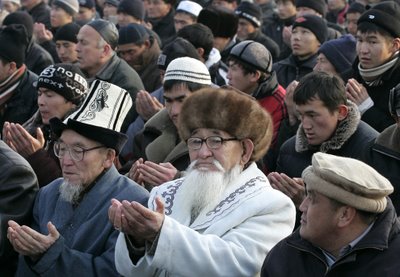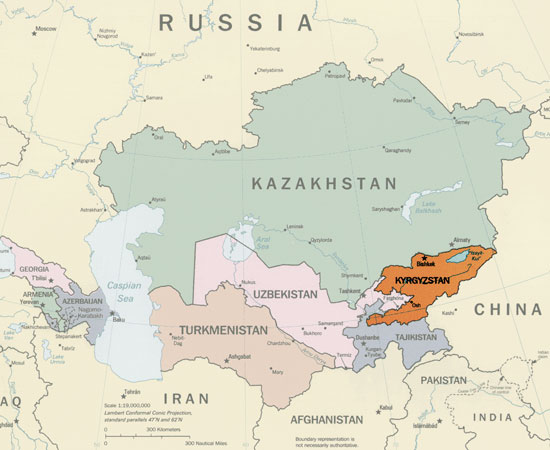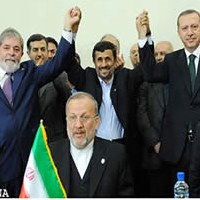Published: april 25, 2010; Intelligence and Terrorism Information Center.
Between Iran and Kyrgyzstan: Kyrgyzstan coup through Iranian eyes
The coup in the former Soviet republic of Kyrgyzstan, in which masses of demonstrators managed to topple the government of President Kurmanbek Bakiyev and force him out of his country, drew considerable interest in Iran as well. While supporters of the reformist opposition emphasized the success of the popular protest and even compared the protest movement in Kyrgyzstan (The Population of Kyrgyzstan is 80% Muslim, 17% Russian Orthodox and 3% other) to that in Iran, government supporters focused on the negative impact of the developments on the world status of the US.
Following the developments in Kyrgyzstan, several Iranian bloggers associated with the reformist opposition expressed envy over the success of the protest movement in that country and frustration over the failure of the Green Movement to bring about a political change in Iran as well.
The following was published in a blog associated with the reformist opposition, under the title of “The story of Kyrgyzstan and the Green Movement”:
“It is said that a group of people came to the river bank and stood there. One of them said that the current was too fast, and backed down. Another said, ‘We must wait patiently until the water is calmer’. A third man suggested building a bridge, and another spoke of unity and said that if everybody held hands, there was nothing the river could do to harm them. Yet another said that the water was cold, which could cause illness, and another called to stand up bravely to the current. By then the current grew even stronger. Suddenly, someone came from the road, rolled up his pants, and crossed the river. He did not even look at the surprised faces of those who still stood on the other bank of the river”
(greenmanifesto).

Kyrgyz men pray on the first day of Eid al-Adha, the Muslim feast of sacrifice, in Bishkek, Kyrgyzstan on December 8, 2008. (Vyacheslav Oseledko/AFP/Getty Images)
A commentary published on the Akhbar-e Rooz website under the title “They did it; so can we” addressed the developments in Kyrgyzstan and the lessons that the Iranian opposition had to learn from them. If the people of Kyrgyzstan had embraced the view of the reformist opposition in Iran, which called to avoid using violence, extremism, and taking revolutionary measures, according to the article, the president of Kyrgyzstan would still be sitting in his chair, the situation was the same, and the government would still be oppressing the opposition leaders. However, in Kyrgyzstan there was a leadership determined to put an end to tyranny and was even willing to use violence for several hours. The author of the article pointed out that he did not intend to encourage the use of violence or taking up an armed struggle; however, the avoidance of various means, which are necessary in any political struggle, was serving the oppressive government. The illusion of reform in a regime incapable of change, a passive outlook erroneously referred to as “peaceful struggle”, and denying the people’s right to defend themselves from violent oppression by the government all constitute a mistake which led Iran’s Green Movement to a dead end and impeded it. The events in Kyrgyzstan are important for the people of Iran, and they must follow them closely since they indicate that, contrary to what reformists say, write, or do, there are other ways to fight tyranny. Those events should also be a lesson for the government of Iran, which must realize that the people of Iran will not follow the reformist policy forever or continue to be afraid of the government’s fire power. The government will not be able to fight the people’s desire to establish a democracy, but it can decide whether the change will be brought about in peaceful means or through the use of violence (Akhbar-e Rooz, April 8).
Another Iranian blogger also addressed the lessons which the Iranian opposition must learn from the events in Kyrgyzstan. The blogger wrote that after he watched the developments in Kyrgyzstan, he came to the conclusion that one of the mistakes made by the Green Movement in Iran was that no attempt was made to take over the IRIB (Iran’s Broadcasting Authority) building during the riots which had broken out in the country following the presidential elections. If just ten thousand people had headed to the building, they could have taken control of it, broadcast an announcement by opposition leader Mir-Hossein Mousavi, and topple the government. One of the major problems of the Iranian opposition, according to the author of the article, is that citizens in smaller cities across Iran were unaware of the situation in Tehran in the first days after the outbreak of the riots, since they were only following the reports published in official media (tunel-sabz.blogsky.com, April 8).

Mosque at Naryn, Kyrgyzstan. The Kyrgyz are Sunni Muslims of the Hanafi school of law. One of the most important holy places for Muslims in Kyrgyzstan is the Throne of Suleyman in the southern city of Osh. It is sometimes referred to by Soviet Muslims as the "second Mecca." By contrast, Islam infiltrated northern Kyrgyzstan in a slower, less encompassing manner. Many ancient indigenous beliefs and practices, including shamanism and totemism, coexisted syncretically with Islam. This split between the northern and southern Kyrgyz in their religious adherence to Muslim practices can still be seen today. A significant number of Kyrgyz observe Muslim practices in their everyday lives but not in a religious sense. Kyrgyz women do not wear veils, nor do they avoid men to whom they are not related.
Government supporters, on the other hand, focused on how the developments in Kyrgyzstan could affect the status of the US and the American foreign policy. The conservative daily Keyhan reported on the developments in Kyrgyzstan and defined the ousting of Bakiyev’s pro-Western government as another blow to the US. According to the daily, Kyrgyzstan played a major part in the American foreign policy as it was home to Manas, the large American military airbase used by US troops on their way to nearby Afghanistan. The daily noted that the ousting of the government in Kyrgyzstan was another blow to the US and to the West, only two months after the defeat of the pro-Western government in the general elections held in the Ukraine last January. The daily argues that the developments in those two countries thwarted the US plans to stage additional velvet coups in Central Asia. While the US was able to deceive public opinion in the Ukraine and Kyrgyzstan and lead two velvet coups in those countries through its proxies, the people of those countries shortly realized that they had been deceived by the West and toppled their governments. Keyhan says that the US attempted to stage a “green coup” in Iran as well; however, the American plot was thwarted thanks to the wisdom of the Supreme Leader and the people of Iran (Keyhan, April 10). The daily also addressed the reports on “anti-revolutionary” media on the events in Kyrgyzstan and attempts to draw parallels between them and the situation in Iran, saying that even opposition supporters who discussed the issue said that there was no room for comparison between the two countries (Keyhan, April 10).
An interesting point of view appeared in reports published in news websites associated with government critics from the conservative bloc on the developments in Kyrgyzstan. Alef and Asr-e Iran, two websites associated with the conservative pragmatic bloc, reported the developments in the former Soviet republic under the title: “Kyrgyzstan government overthrown as a result of electricity price increase”. The websites noted that, according to commentators, the main reason for the public protest which eventually toppled the government was the dramatic increase in gas and electricity prices in the country (Asr-e Iran, April 8; Alef, April 9). It appears that the websites sought to issue a warning over the possible political repercussions of a dramatic increase in the prices of gas and electricity in Iran as well, owing to the imprudent implementation of the coming reform in the government subsidy policy. It should be noted that the political conflict between the government and the Majles over the implementation of the reform has escalated in recent weeks.



 RSS
RSS











Kyrgyzstan Coup through Iranian Eyes #iran #kyrgyzstan http://j.mp/csyv73
RT @CrethiPlethi: Kyrgyzstan Coup through Iranian Eyes #iran #kyrgyzstan http://j.mp/csyv73
[…] This post was mentioned on Twitter by Elisabeth, Crethi Plethi. Crethi Plethi said: Kyrgyzstan Coup through Iranian Eyes #iran #kyrgyzstan http://j.mp/csyv73 […]
[…] The blogger wrote that after he watched the developments in Kyrgyzstan, he came to the conclusion that one of the mistakes made by the Green Movement in Iran was that no attempt was made to take over the IRIB (Iran’s Broadcasting Authority) building …. You can help us to bring you in depth information on Middle East Affairs, Israel and global Islam. Your donation will also help us in our ability to support a pro-Israel lobby. Read the original: Kyrgyzstan Coup Through Iranian Eyes | Middle East Affairs … […]